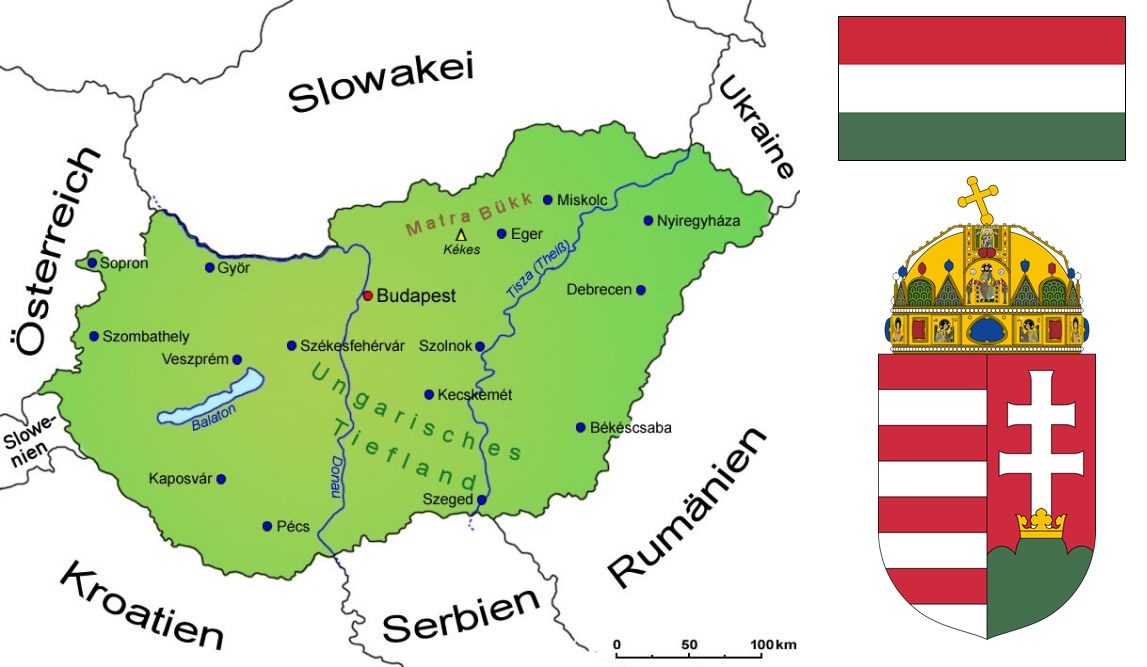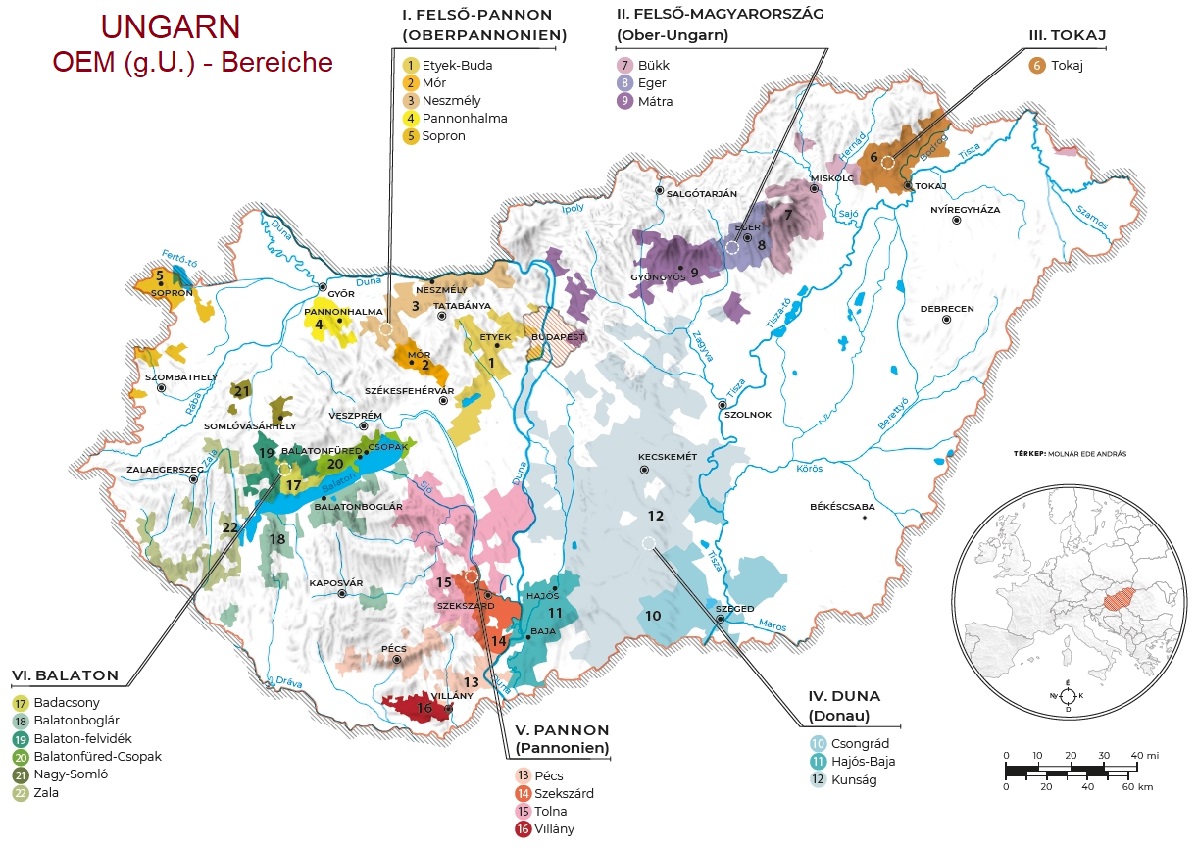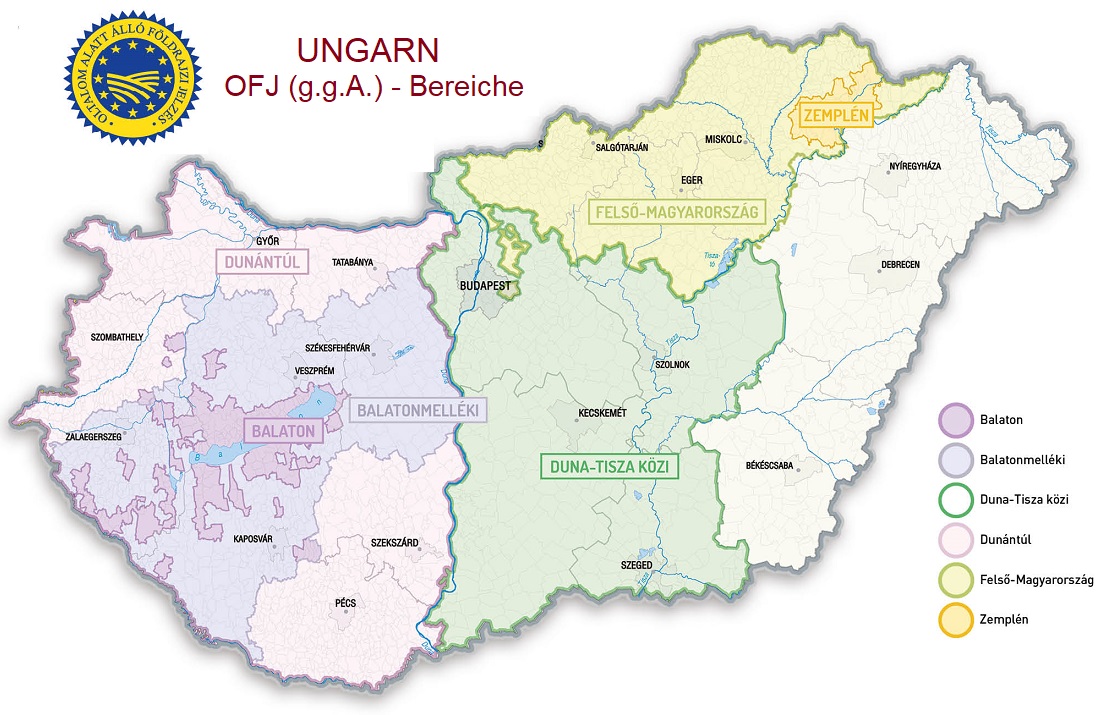Results
2,284 Results
Loading more Results ...
Loading more Results ...
Wine regions in Hungary 22 growing regions
Description to Hungary
The parliamentary republic of Hungary (Magyarország in Hungarian) in Central Europe with its capital Budapest covers 93,036 km². Located in the Pannonian Basin and crossed by the Danube, the country borders Slovakia and Ukraine to the north, Romania to the east, Serbia and Croatia to the south, and Slovenia and Austria to the west.

History
Hungary has a very old wine-growing culture, as wines from Sopron and Eger were already well known in the 13th century. Viticulture in the Carpathian Basin was characterised by ancient Central Asian traditions as well as Roman wine culture. Despite various wars and unrest, wine has been cultivated here for over 1,000 years. Even the Ottomans, who occupied most of the country for around 160 years, did not suppress viticulture despite the ban on alcohol and were happy to collect taxes for it, but development was inhibited during this time. According to legend, Emperor Charlemagne (742-814) was so enthusiastic about "Avar wine" that he had some vines brought to Germany.
The Hungarian King Matthias Corvinus (1440-1490), who resided in Vienna (Austria) in the last five years of his life, is recorded as saying that "all the people should have wine and the winegrowers should be held in high esteem". In the Middle Ages, as in many countries, the Catholic Church played a key role in the spread of viticulture and wine culture in Hungary. The famous Tokay is decisively linked to the history of wine in Hungary. After the phylloxera catastrophe and the two world wars, the focus shifted to the production of mass-produced wines. However, since the political upheavals of 1989 and the re-establishment of the winegrowers' association, viticulture has been on the rise again.
Wine-growing regions
Hungary has a variety of soil types, from sand, loess, loam, limestone and marl to various volcanic rocks such as basalt, tuff and andesite. The climate is Central European and continental with hot summers and cold winters. The 223 registered grape varieties (over 60 of which are indigenous) are predominantly white wine varieties. However, around 2,000 hours of sunshine a year and various microclimates also favour the production of red wines. The Danube, which flows from north to south, divides the country into roughly two large halves.
Hungary is divided into six wine-growing regions (Borrégió). These consist (with the exception of Tokaji) of several wine-growing regions (Borvidék). There are 22 wine-growing regions, all of which are considered OEM(PDO = protected areas of origin for quality wines). In some wine-growing regions there are smaller PDO areas as enclaves. There are 33 protected designations of origin in total (status mid-2021). This number is constantly increasing thanks to rapid developments.

Wine-growing regions (Borréggió) and wine-growing areas (Borvidék) = OEM and PDO respectively .
The 6 wine-growing regions with a total of 33 OEM (PDO) areas:
Balaton (Lake Balaton )
- Badacsony
- Balatonboglár
- Balatonfüred-Csopak
- Balaton-felvidék
- Csopak
- Káli
- Nagy-Somló
- Somló
- Tihany
- Zala
Duna (Danube)
Felső-Magyarország (Upper Hungary)
Felső-Pannon (Upper Pannonia)
- Etyek-Buda
- Etyeki-Pezsgő
- Mór
- Neszmély
- Pannonhalma
- Sopron (Ödenburg)
Pannon (Pannonia)
Tokaji (Tokaj)
The famous Tokaj is produced in the Tokaj-Hegyalja region. A speciality is a small area in the east of Slovakia, which borders directly on the region. Here, a Tokaj-style wine is produced in the three (formerly Hungarian) municipalities of Kistoronya, Szõlõske and the Slovakian part of Sátoraljaújhely. After years of disputes, the two countries agreed in 2003 that these wines produced within the 172-hectare area could bear the Tokaji designation of origin.
Country wine areas (Tájbor) = OFJ or PGI.

There are 6 country wine areas. Two of them, namely Balaton and Felső-Magyarország, are identical in designation to the 6 wine-growing regions listed above
- Balaton (Lake Balaton)
- Balatonmelléki
- Duna-Tisza közi
- Dunántúli
- Felső-Magyarország (Upper Hungary)
- Zemplén
Grape variety index
In 2022, the vineyards covered 60,161 hectares and the wine production volume was 2.5 million hectolitres. Hungary is predominantly a white wine country with just under 70% of production, although the red wine variety Kékfrankos (Blaufränkisch) dominates. The grape variety index (statistics from the Hungarian Ministry of Agriculture):
Grape variety name |
Synonyms / Hungarian name |
Colour |
Hectare |
| Blaufränkisch | Kékfrankos | red | 7.279 |
| Bianca | Egri Csillagok 40 | white | 5.180 |
| Cserszegi Fűszeres | - | white | 3.984 |
| Furmint | - | white | 3.574 |
| Welschriesling | Olasz Rizling | white | 3.274 |
| Cabernet Sauvignon | - | red | 2.367 |
| Chardonnay | - | white | 2.069 |
| Merlot | - | red | 2.024 |
| Aletta | Egri Csillagok 18 | white | 1.933 |
| Irsai Olivér | - | white | 1.835 |
| Pinot Gris | Szürkebarát | white | 1.606 |
| Hárslevelű | - | white | 1.477 |
| Zweigelt | - | red | 1.398 |
| Cabernet Franc | - | red | 1.370 |
| Müller-Thurgau | Rizlingszilváni | white | 1.304 |
| Grüner Veltliner | Zöld Veltelini | white | 1.273 |
| Muscat Ottonel | Ottonel Muskotály | white | 1.158 |
| Riesling | Rajnai Rizling | white | 1.142 |
| Pinot Noir | Kék Burgundi, Kisburgundi | red | 1.089 |
| Sauvignon Blanc | Sauvignon | white | 939 |
| Blauer Portugieser | Portugieser, Kék Oportó, Kék Portugizi | red | 840 |
| Muscat Blanc / Muscat | Muscat Lunel, Muskotály | white | 830 |
| Chasselas | Fehér Gyöngszőlő, Fehér Chasselas, Saszla | white | 784 |
| Királyleányka | - | white | 770 |
| Kunleány | - | white | 720 |
| Gewürztraminer / Traminer | Fűszeres Tramini, Piros Tramini / Tramini | white | 691 |
| Zala Gyöngye | - | white | 680 |
| Zenit | - | white | 672 |
| Leányka | - | white | 560 |
| Generosa | Kecskemét 15 | white | 518 |
| Kövidinka | Ruzsitza | white | 518 |
| Blue Burgundy | - | red | 442 |
| Ezerjó | Budai Fehér | white | 402 |
| Arany Sárfehér | Izsáki Sárfehér, Fehér Dinka | white | 327 |
| Kadarka | Kék Kadarka | red | 276 |
| Syrah | - | red | 270 |
| Pinot Blanc | Fehér Burgundi | white | 227 |
| Villard Blanc | - | white | 197 |
| Viktória Gyöngye | - | white | 180 |
| Zengő | Badacsony 8 | white | 179 |
| Turán | Agria | red | 169 |
| Juhfark | - | white | 167 |
| Ezerfürtű | Kecskemét 5 | white | 141 |
| Pölöskei Muskotály | - | white | 116 |
| Medina | Egri Csillagok 7, Medea | red | 114 |
| Zéta | Oremus | white | 111 |
| Nero | - | red | 97 |
| Bíborkadarka | Bíbor Kadarka | red | 83 |
| Lakhegyi Mézes | - | white | 81 |
| Menoir | formerly Kékmedoc or Médoc Noir | red | 62 |
| Kéknyelű | - | white | 46 |
| Duna Gyöngye | - | red | 44 |
| Grasă de Cotnari | Grasă, Kövérszőlő | white | 41 |
| Karát | Kecskemét 6 | white | 40 |
| Jubileum 75 | Jubilejne 75, Kecskemét 11, Miklostelep 11 | white | 37 |
| Csaba Gyöngye | - | white | 35 |
| Kabar | - | white | 34 |
| Dornfelder | - | red | 31 |
| Zeusz | Zeus | white | 28 |
| Bácska | Ister | white | 26 |
| Panonia | Castellum, Panonija | white | 25 |
| Ulysses | - | white | 25 |
| Sémillon | - | white | 24 |
| Zierfandler | Cirfandli | white | 22 |
| Csillám | - | white | 20 |
| Nektár | - | white | 21 |
| Rózsakö | - | white | 17 |
| Viognier | - | white | 14 |
| Pannon Frankos | - | red | 14 |
| Mátrai Muskotály | - | white | 14 |
Wine law
In August 2009, the EU wine market regulation came into force for all member states with fundamental changes to wine designations and quality levels. The designations are (see also under Quality System):
FN (Földrajzi jelzés Nélküli) - Bor (formerly Asztali Bor or table wine)
Wine without origin
OFJ = PGI (oltalom alatt álló földrajzi jelzés) - Tájbor or country wine
There are 6 country wine areas, which are characterised by a blue-yellow seal on the label; see above.
OEM = PDO (Oltalom alatt álló Eredetmegjelölésű Bor)
Minőségi Bor / Védett eredetű Bor - quality wine
Wine with protected origin. There are 22 wine-growing regions (which are automatically also OEM or PDO) with a total of 33 quality wine areas, which are characterised by an orange-red seal on the label (see above).
OEM DHC (Districtus Hungaricus Controllatus)
This quality level, introduced in 2003, corresponds to the DAC system in Austria. There are three levels: Classicus, Premium and Super Premium. These wines are characterised by a specific flavour style typical of the area. The individual OEM areas are free to decide on their use and also define the specifications. The DHC areas are Izsáki Arany Sárfehér and Villány.
Wine types & wine names
The place name ending in "i" (which corresponds to the German "er" such as "Gumpoldskirchner") is usually followed by the grape variety, for example "Soproni Kékfrankos" (Blaufränkisch from Sopron).
- Aszú = Trockenbeerenauslese only for Tokaji
- Bikavér = bull's blood (only PDO Eger and Szekszárd)
- Jégbor = ice wine
- Fehérbor = white wine
- Fiatal Bor = young wine or Újbor (new wine)
- Késői Szüret (Késői szüretelésű bor) = late harvest
- Muzeális Bor = wine with at least 5 years of bottle ageing
- Narancsbor = Orange Wine
- Pezsgőbor (Pezsgő), Francia Pezsgőbor (Champagne) = Sparkling wine
- Rozé = rosé wine
- Siller = lightly pressed red wine
- Vörösbor = red wine
Wine ageing terms
- Barrique Érlelésű Bor = wine matured in barriques
- Sugar content: száraz = dry, félszáraz = semi-dry, édes = sweet, félédes = semi-sweet
Map: © Goruma
Flag: by SKopp, Public domain, Link
Coat of arms: Public domain, Link
Map of wine-growing regions: Magyar Turisztikai Ügynökség
Map OFJ: Agrárminisztérium Borászati és Kertészeti Főosztály
Source: Kristian Kielmayer
Classified wine producers in Hungary 6
find+buy for Hungary 22
Recent wines 624
 Hummel Pincészet - Weingut Hummel
— Südliches Transdanubien
2012 Villány-Siklós Villány Merlot trocken Xeyn, DHC Classicus
91 WP
excellent
25.00 €
Hummel Pincészet - Weingut Hummel
— Südliches Transdanubien
2012 Villány-Siklós Villány Merlot trocken Xeyn, DHC Classicus
91 WP
excellent
25.00 €

 Hummel Pincészet - Weingut Hummel
— Südliches Transdanubien
2022 Villány-Siklós Furmint trocken
89 WP
very good
25.00 €
Hummel Pincészet - Weingut Hummel
— Südliches Transdanubien
2022 Villány-Siklós Furmint trocken
89 WP
very good
25.00 €

 Hummel Pincészet - Weingut Hummel
— Südliches Transdanubien
2022 Villány-Siklós trocken "Bernstein"
90 WP
excellent
19.50 €
Hummel Pincészet - Weingut Hummel
— Südliches Transdanubien
2022 Villány-Siklós trocken "Bernstein"
90 WP
excellent
19.50 €

 Hummel Pincészet - Weingut Hummel
— Südliches Transdanubien
2022 Villány-Siklós Portugieser trocken
86 WP
very good
13.50 €
Hummel Pincészet - Weingut Hummel
— Südliches Transdanubien
2022 Villány-Siklós Portugieser trocken
86 WP
very good
13.50 €
